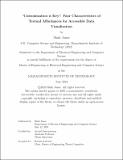“Customization is Key”: Four Characteristics of Textual Affordances for Accessible Data Visualization
Author(s)
Jones, Shuli
DownloadThesis PDF (1.284Mb)
Advisor
Satyanarayan, Arvind
Terms of use
Metadata
Show full item recordAbstract
Current best practices recommend using textual descriptions to make data visualizations accessible to blind and low vision (BLV) screen reader users. While recent research has explored laying out such descriptions hierarchically to enable reading varying levels of detail, the textual descriptions remain fixed: their syntax and semantics are set by the visualization author or tool, and cannot be changed by a BLV user based on their preferences or task-specific needs. In this thesis, I explore four characteristics of customizations for hierarchical textual descriptions of visualizations: presence, or what content is present in the description; verbosity, or the length and conciseness of the content; ordering, or the sequencing of content; and duration, or how long a particular customization lasts. I instantiate these characteristics as extensions to Olli, an open source library that converts web-based visualizations into hierarchical textual structures, and evaluate my work through a mixed-methods study with 13 BLV participants. Users reported that customization is crucial to their agency and that being able to change the four characteristics helps them efficiently carry out their desired tasks on the data. However, differences in preferred defaults, prior experiences, and enthusiasm for customization indicate that there is no one-size-fits-all system even for customization itself: both accessible data visualizations and user interfaces for customizing them must be flexible enough to meet a variety of needs.
Date issued
2023-06Department
Massachusetts Institute of Technology. Department of Electrical Engineering and Computer SciencePublisher
Massachusetts Institute of Technology